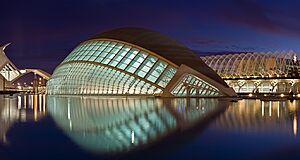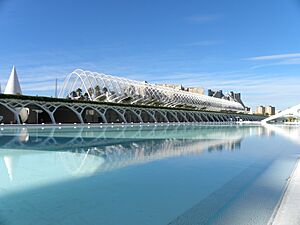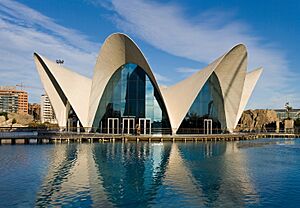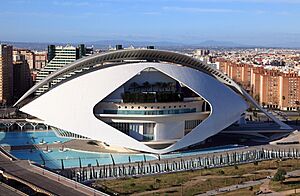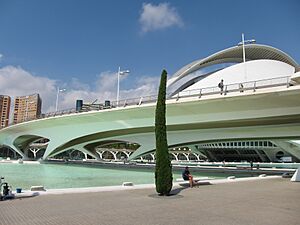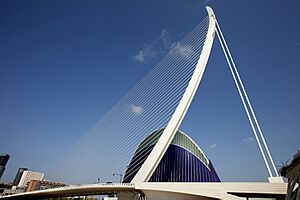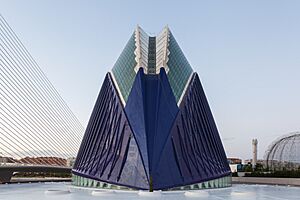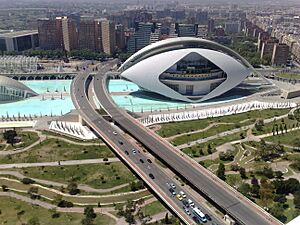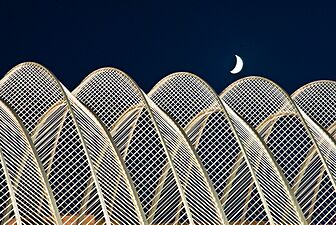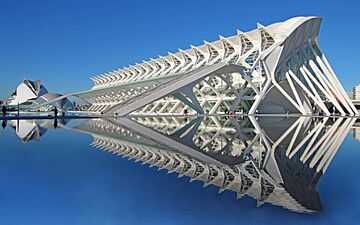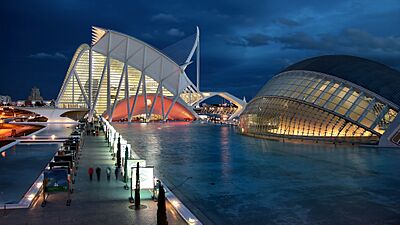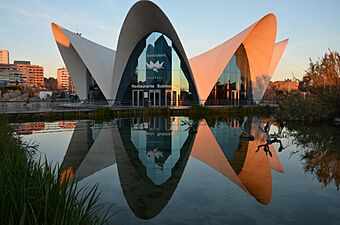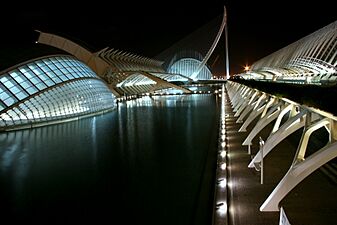City of Arts and Sciences facts for kids
|
Valencian: Ciutat de les Arts i les Ciències
|
|
|
Spanish: Ciudad de las Artes y las Ciencias
|
|
 |
|
| Location | Valencia, Spain |
|---|---|
| Coordinates | 39°27′15″N 00°21′00″W / 39.45417°N 0.35000°W |
| Owner | Ciudad de las Artes y las Ciencias, S.A. (CACSA) |
| Construction | |
| Opened | L'Hemisfèric (1998), Museu de les Ciències Príncipe Felipe (2000), L'Umbracle (2001), L'Oceanogràfic (2003), Palau de les Arts Reina Sofía (2005), Montolivet Bridge (2007), Assut de l'Or Bridge (2008), L'Àgora (2009) |
| Construction cost | 1,200 million euros |
| Architect | Santiago Calatrava, Félix Candela (L'Oceanogràfic) |
The City of Arts and Sciences (Valencian: Ciutat de les Arts i les Ciències, Spanish: Ciudad de las Artes y las Ciencias) is an amazing group of buildings in Valencia, Spain. It's a super popular place for tourists and locals. Many people think it's one of the most important modern places to visit in Valencia. It's even considered one of the 12 Treasures of Spain!
This cool complex is built on what used to be the Turia River bed. The river was moved after a big flood in 1957. Now, the old riverbed is a beautiful park. The City of Arts and Sciences was designed by famous architects Santiago Calatrava and Félix Candela. Construction started in 1996. The first part, L'Hemisfèric, opened in 1998. The last main building, the Palau de les Arts Reina Sofía, opened in 2005. The newest building, L'Àgora, opened in 2009.
Contents
- Discover the Amazing Buildings
- L'Hemisfèric: The Giant Eye
- Museu de les Ciències Príncipe Felipe: The Science Whale
- L'Umbracle: The Shaded Garden Walk
- L'Oceanogràfic: Europe's Biggest Aquarium
- Palau de les Arts Reina Sofía: The Opera House
- Montolivet Bridge: A Modern Crossing
- Assut de l'Or Bridge: The City's Tallest Point
- L'Àgora: The Event Plaza
- Valencia Towers: Future Plans
- How the City of Arts and Sciences Began
- Meet the Architects
- Economic Impact
- Gallery
- See also
Discover the Amazing Buildings
The City of Arts and Sciences has several incredible buildings. Each one has a unique design and purpose. They were opened one by one over several years.
L'Hemisfèric: The Giant Eye
Opened in 1998, L'Hemisfèric is an IMAX Cinema, a planetarium, and a laser show theater. It's designed to look like a giant eye. This building was the first part of the complex to be finished. Its "eyelid" opens up to show the dome inside, which is like the "iris" of the eye. The building is about 110 meters (360 feet) long. If you stand at opposite pillars inside, you can hear each other speak!
Museu de les Ciències Príncipe Felipe: The Science Whale
The Museu de les Ciències Príncipe Felipe opened in 2000. It's an interactive science museum. It looks like the skeleton of a huge whale. The museum has three floors. The first floor offers great views of the surrounding Turia Garden. The second floor has exhibits about famous scientists. On the third floor, you can explore the "Chromosome Forest," which teaches about human DNA. There are also cool exhibits like "Zero Gravity" and "Space Academy." This museum is the largest in Spain, with lots of space for exhibitions.
L'Umbracle: The Shaded Garden Walk
Opened in 2001, L'Umbracle is an open structure with a beautiful garden walk. It features plants native to Valencia, like palm trees, rosemary, and lavender. It's also an outdoor art gallery called "The Walk of the Sculptures." Here, you can see sculptures by modern artists, including Yoko Ono. L'Umbracle is designed as an entrance to the City of Arts and Sciences. It's about 320 meters (1,050 feet) long. The plants are chosen to change colors with the seasons, making it beautiful all year round.
L'Oceanogràfic: Europe's Biggest Aquarium
L'Oceanogràfic opened in 2003. It's the largest oceanographic aquarium in Europe! It's shaped like a water lily. This amazing place is home to over 500 different types of sea creatures. You can see dolphins, belugas, sharks, penguins, sea lions, and many more. Each building inside represents a different ocean environment, like the Mediterranean Sea, the Arctic, and tropical seas.
Palau de les Arts Reina Sofía: The Opera House
The Palau de les Arts Reina Sofía opened in 2005. It's an opera house and a center for performing arts. It hosts many events like opera, theater, and music concerts. The building has a unique metallic "feather" roof that is 230 meters (755 feet) long. Inside, panoramic lifts and stairs connect different levels. It's surrounded by beautiful gardens and water.
Montolivet Bridge: A Modern Crossing
The Montolivet Bridge was completed in 2007. It's a concrete road bridge that crosses the old Turia riverbed. It connects with the newer, curved part designed by Santiago Calatrava. This bridge fits perfectly with the modern design of the nearby Palau de les Arts Reina Sofía and L'Hemisfèric.
Assut de l'Or Bridge: The City's Tallest Point
The Assut de l'Or Bridge opened in 2008. It's a white cable-stayed bridge that also crosses the dry Turia riverbed. It connects the south side of the complex to Minorca Street. The tall pylon (support tower) of this bridge is about 125 meters (410 feet) high. This makes it the highest point in the entire city of Valencia!
L'Àgora: The Event Plaza
L'Àgora opened in 2009. It's a covered plaza designed to host many different events. You might see concerts, performances, exhibitions, or even sports events here, like the Valencia Open 500 tennis tournament. It's a very flexible space for all sorts of gatherings.
Valencia Towers: Future Plans
The Valencia Towers were part of a bigger plan by Calatrava from 2005. This plan included building three tall towers, symbolizing the cities of Valencia, Alicante, and Castellón. However, this project is currently on hold.
How the City of Arts and Sciences Began
The idea for this amazing complex started in 1989. The president of the Valencian government, Joan Lerma, wanted to create a "City of Science and Technology" for Valencia. A scientist named Antonio Ten Ros helped create the first plans.
The first idea was called "Vilanova, A City of Science for Valencia." It included a very tall communications tower, a planetarium, and a science museum. The total cost was estimated to be a lot of money. In 1991, the land for the project was approved. Santiago Calatrava was chosen to design the first three buildings.
Over time, the plans changed and grew. In 1996, the communications tower was replaced with an opera house, which was more expensive. Architect Félix Candela joined the team to design the oceanographic park. The project's name was changed to the "City of Arts and Sciences." Construction continued, and the final building, L'Agora, was finished in 2009. The total cost for the entire project was about 1.2 billion euros.
Meet the Architects
The City of Arts and Sciences was designed by two very talented architects.
Santiago Calatrava
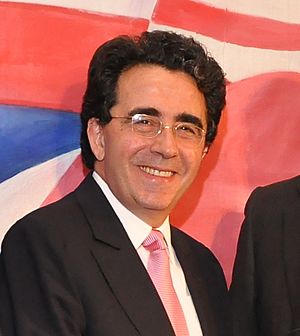
Santiago Calatrava was born in Valencia, Spain, in 1951. He is not only an architect but also an engineer, painter, and sculptor. Calatrava's designs often combine structure with a sense of movement. For example, the Planetarium in the City of Arts and Sciences opens and closes like an eyelid. He often uses water in his designs to create beautiful reflections, especially since Valencia is a dry city near the sea. He also used traditional ceramic mosaic tiles, called "trencadis," on many of the buildings.
Félix Candela
Félix Candela was born in Madrid, Spain, in 1910 and passed away in 1997. He was known for his unique designs using reinforced concrete structures. His buildings often featured thin, curved shells. Félix Candela designed the incredible underwater city of L'Oceanogràfic in the City of Arts and Sciences. His work is sometimes compared to the famous architect Antoni Gaudí in Barcelona.
Economic Impact
The City of Arts and Sciences is not just a beautiful place; it also helps the local economy. In 2019, it was reported that the complex brings in about 113 million euros each year. It also creates many jobs, around 3,509 positions.
Gallery
See also
 In Spanish: Ciudad de las Artes y las Ciencias para niños
In Spanish: Ciudad de las Artes y las Ciencias para niños


